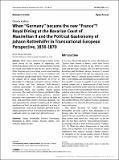Files in this item
When ‘Germany’ became the new ‘France’? Royal dining at the Bavarian court of Maximilian II and the political gastronomy of Johann Rottenhöfer in transnational European perspective, 1830-1870
Item metadata
| dc.contributor.author | Kreklau, Claudia | |
| dc.date.accessioned | 2019-09-24T16:30:01Z | |
| dc.date.available | 2019-09-24T16:30:01Z | |
| dc.date.issued | 2017 | |
| dc.identifier | 261276528 | |
| dc.identifier | 0c67d5e3-471e-4afd-9d28-077fd24b7e82 | |
| dc.identifier.citation | Kreklau , C 2017 , ' When ‘Germany’ became the new ‘France’? Royal dining at the Bavarian court of Maximilian II and the political gastronomy of Johann Rottenhöfer in transnational European perspective, 1830-1870 ' , International Review of Social Research , vol. 7 , no. 1 , pp. 46-56 . https://doi.org/10.1515/irsr-2017-0006 | en |
| dc.identifier.issn | 2069-8534 | |
| dc.identifier.other | ORCID: /0000-0002-1621-5300/work/61978990 | |
| dc.identifier.uri | https://hdl.handle.net/10023/18550 | |
| dc.description.abstract | While France defined European hâute cuisine (royal dining for the purpose of expressing rankdistinction) around 1800, by the mid-nineteenth century the French court failed to hold the best chefs of Europe. Other European courts were rising in power and asserting their absolutist ideals in the century of revolution and socio-political change using meals. Within this context, the culinary art of Johann Rottenhofer in service of Maximilian II of Bavaria synthesized Antonin Careme’s hâute cuisine and Jean Anthelme Brillat-Savarin’s “political gastronomy” to communicate peace, foster international bonds, and establish equality among sovereigns. The works of Levi-Strauss and Norbert Elias find resonance in these culinary practices, wherein monarchs were represented at the table in the form of food. Mid-nineteenth century European monarchs not only appreciated the cultural symbolism and the political significance of food, but actively exploited it as a form of communication. I rely on the typologies provided by Ken Albala and Sara Peterson to decode food meanings in the cookbooks written by royals’ chefs after retirement. | |
| dc.format.extent | 1459809 | |
| dc.language.iso | eng | |
| dc.relation.ispartof | International Review of Social Research | en |
| dc.subject | Johann Rottenhofer | en |
| dc.subject | Political gastronomy | en |
| dc.subject | Maximilian II | en |
| dc.subject | Haute Cuisine | en |
| dc.subject | Antonin Careme | en |
| dc.subject | Jean Anthelme Brillat-Savarin | en |
| dc.subject | DC France | en |
| dc.subject | DD Germany | en |
| dc.subject | T-NDAS | en |
| dc.subject.lcc | DC | en |
| dc.subject.lcc | DD | en |
| dc.title | When ‘Germany’ became the new ‘France’? Royal dining at the Bavarian court of Maximilian II and the political gastronomy of Johann Rottenhöfer in transnational European perspective, 1830-1870 | en |
| dc.type | Journal article | en |
| dc.contributor.institution | University of St Andrews. School of History | en |
| dc.identifier.doi | https://doi.org/10.1515/irsr-2017-0006 | |
| dc.description.status | Peer reviewed | en |
This item appears in the following Collection(s)
Items in the St Andrews Research Repository are protected by copyright, with all rights reserved, unless otherwise indicated.

